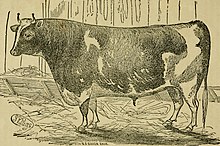Alderney cattle
 From Wikipedia - Reading time: 4 min
From Wikipedia - Reading time: 4 min
 Bull, illustration from 1860 | |
| Conservation status | Extinct |
|---|---|
| Country of origin | Channel Islands |
| Distribution | British Isles |
| Use | Dairy |
| Traits | |
| Coat | Dun, fawn, light red or yellow, with or without patches of white |
| Horn status | Short |
| |
The Alderney is an extinct breed of dairy cattle. It originated in, and is named for, the island of Alderney in the Channel Islands.[1]: 103 [2]: 139 It was one of three breeds of Channel Island cattle, the others being the Jersey and the Guernsey. In the eighteenth and nineteenth centuries "Alderney" was a general term for cattle from the archipelago; many were exported to mainland Britain under this name, regardless of which of the islands they came from.
History
[edit]Cattle are thought to have been brought to the Channel Islands during the tenth and eleventh centuries, possibly from about AD 960 when Richard I of Normandy is believed to have sent monks from Mont-Saint-Michel to help the islanders to defend themselves against attacks by pirates.[1]: 192 These monks are thought to have brought with them cattle of Norman or Breton type, perhaps similar to the modern Froment du Léon of Brittany; these were used principally as draught animals, but also as dairy cattle.[2]: 143 Later, when horses replaced oxen for draught work, the cattle began to be selected for milk alone.[2]: 143
From the seventeenth century[1]: 103 or from no later than 1724,[2]: 140 cattle from the Channel Islands began to be exported in considerable numbers to mainland Britain. Regardless of which island they came from, these were invariably known as "Alderneys"; this may have been because Alderney, lying to the north of the other main islands, would have been the last port of call before the Channel crossing.[1]: 103 In the mid-1770s some 900 cattle were being shipped to Britain each year under the Alderney name, about two thirds of them from the island of Jersey.[2]: 140 They were kept mostly by wealthy landowners as decorative "park cattle", though the quality of the milk and of the butter made from it was recognised.[3]: 31
The Alderney contributed to the development of a number of British breeds, principally the Ayrshire and the South Devon. It may also have influenced the Dairy Shorthorn (through its predecessor the Holderness), the Irish Kerry and the Suffolk Dun.[1]: 103
During the Second World War a small number of Alderneys were moved to Guernsey;[1]: 192 the Alderney was absorbed into the Guernsey breed.[4]: S7
Characteristics
[edit]The Alderney was small; its conformation was typical of a dairy breed, with a light bone structure and a somewhat deer-like appearance. The colour of the coat was variable, ranging through shades of dun, fawn, light red and yellow, either with or without patches of white.[1]: 103 [2]: 139 [3]: 31
Use
[edit]The cattle of the Channel Islands were originally used principally as draught animals; later, when horses replaced oxen for draught work, the cattle were reared for milk alone.[2]: 143
The milk was rich in fat, and suitable for butter-making. A description from 1909 says of it "The Alderney ranks as the best butter cow in the world, whilst its abundant yield of milk, rich in cream, is phenomenal";[5]: 81 by 1939 the same sentence had been altered to read "The Jersey ...".[6]: 22
References
[edit]- ^ a b c d e f g Valerie Porter, Lawrence Alderson, Stephen J.G. Hall, D. Phillip Sponenberg (2016). Mason's World Encyclopedia of Livestock Breeds and Breeding (sixth edition). Wallingford: CABI. ISBN 9781780647944.
- ^ a b c d e f g Marleen Felius (1995). Cattle Breeds: An Encyclopedia. Doetinchem, Netherlands: Misset. ISBN 9789054390176.
- ^ a b Valerie Porter (2009). British Cattle. Botley, Oxford: Shire Publications. ISBN 9780747807643.
- ^ Marleen Felius, Marie-Louise Beerling, David S. Buchanan, Bert Theunissen, Peter A. Koolmees and Johannes A. Lenstra (2014). On the History of Cattle Genetic Resources. Diversity 6 (4): 705–750. doi:10.3390/d6040705
- ^ Frank Townsend Barton (1909). The Stock-owners' Manual. London: Everett & Company.
- ^ Frank Townend Barton (1939). Cattle, Sheep and Pigs: Their Practical Breeding and Keeping, third edition. London: Jarrolds Publishers Limited
 KSF
KSF